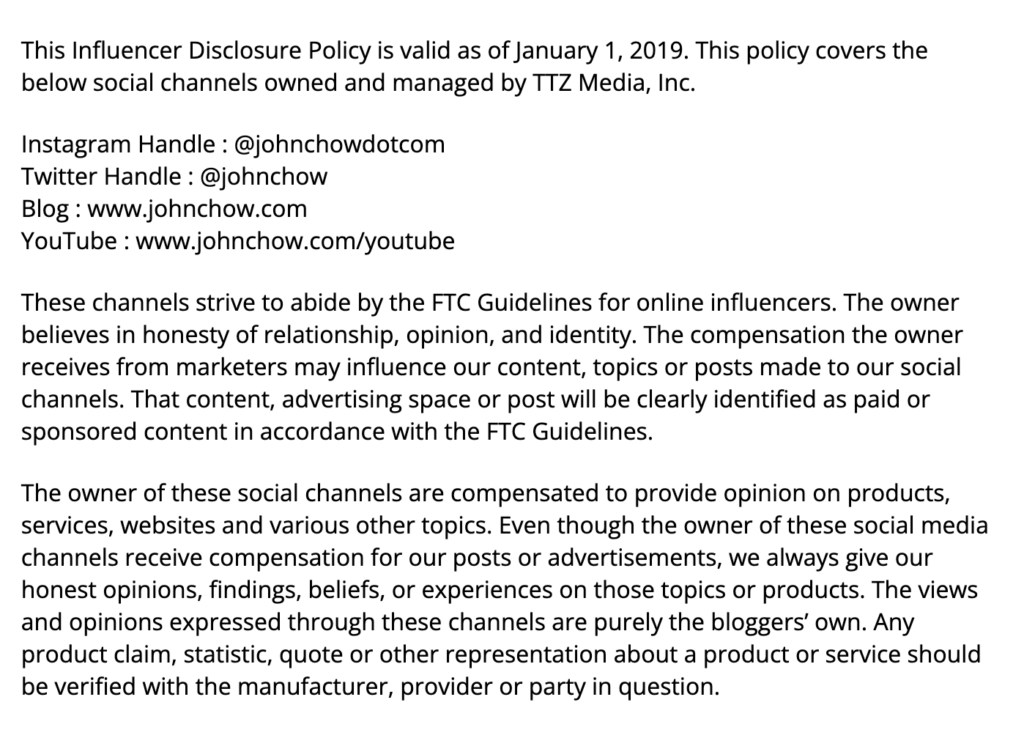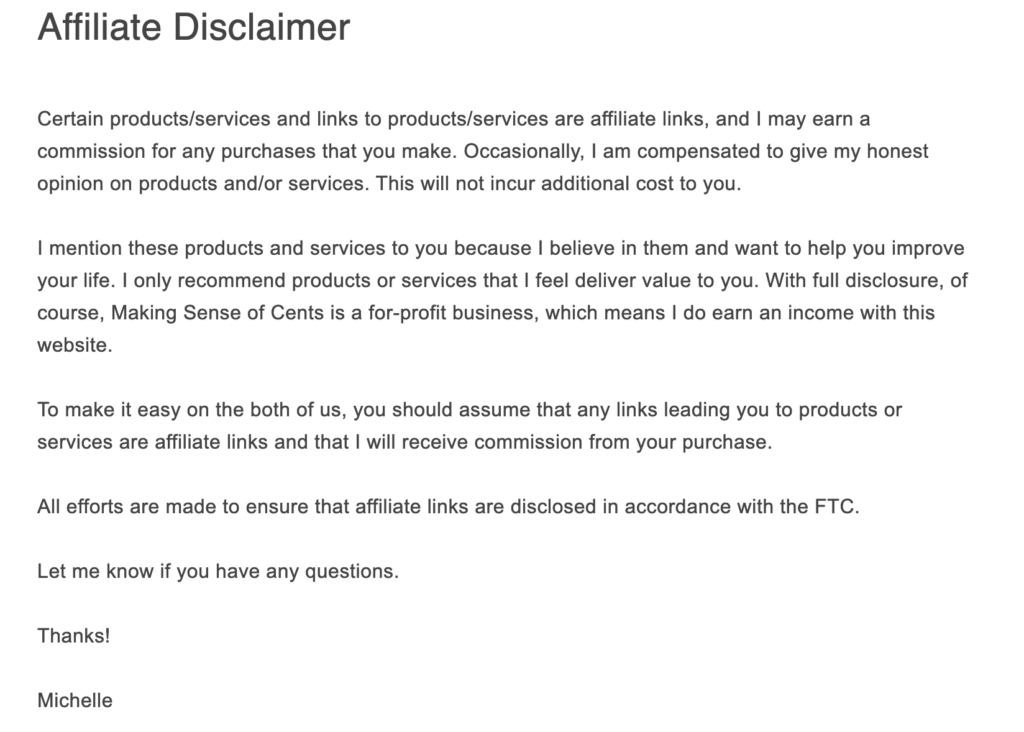13 Best Affiliate Link Disclaimer Examples: FTC And Amazon Associates Disclosures

When you buy something through one of the links on our site, we may earn an affiliate commission.
Looking at the best affiliate link disclosure examples is an excellent way to learn how to write your affiliate link disclaimer.
Affiliate disclosures are also an essential requirement if you want to earn from affiliate marketing. They keep you compliant with the law, search engines, and the sites running the affiliate programs.
Not having an affiliate disclosure can get your affiliate marketing program accounts banned, and in rare cases, could result in a fine.
This article will show you 13 different affiliate disclosures from various sites monetizing with affiliate marketing.
I'll also cover:
- The importance of having an affiliate disclaimer
- How to write an affiliate disclosure
- Who needs to disclose affiliate links
- Where to add your affiliate disclosure
- The Amazon Associates disclosure requirements
- Plus, everything else there is to know about affiliate disclosures
Ready to start?
Good, let's begin with the basics.
Contents
- What Is An Affiliate Link Disclaimer?
- The Different Types Of Affiliate Link Disclosures
- Why Do You Need An Affiliate Disclosure?
- How Do I Write An Affiliate Disclosure?
- Affiliate Link Disclosure Examples
- Do You Have To Disclose Affiliate Links In Email?
- Do YouTubers Have To Disclose Affiliate Links?
- How To Add A Disclosure On Twitter
- Tips For Creating An Affiliate Link Disclosure
- FTC And Amazon Affiliate Disclosures
What Is An Affiliate Link Disclaimer?
An affiliate link disclaimer is a statement that informs people that you have an affiliation with certain brands, products, and services.
It tells those reading your content that the links on the page, website, or email will contain affiliate links, and if they purchase anything from using the link, you will receive a percentage of the fee from the product owner.
In other words, it's a way for affiliate marketers to be honest and upfront with their readers.
They can be short or long, and they must state that you are an affiliate and that the links are affiliate links.
The Different Types Of Affiliate Link Disclosures
As mentioned above, the disclaimers will need to state that you're an affiliate and that you have affiliate links on the page.
However, some product websites will specify that you need to use their affiliate disclaimer or include a particular part of it.
For example, the Amazon Associates program requires that you must state the following on your website:
“As an Amazon Associate, I earn from qualifying purchases.”
And Clickbank says that you must state the following:
“This page contains affiliate links. If you choose to purchase after clicking a link, I may receive a commission at no extra cost to you.”
It's essential to read the terms for these websites because not displaying the correct affiliate disclosure for specific affiliate marketplaces could get you banned, and you could lose any commissions you have earned.
Why Do You Need An Affiliate Disclosure?
It wasn't that long ago when disclaimers for affiliates weren't required.
You could link to a product on Amazon, for example, and the person who clicked on the link had no idea whether it was an affiliate link or not.
You could have an entire eCommerce site full of products, and every item could have been an affiliate product for another supplier. The shopper on the website typically had no idea that the products weren't yours.
However, this ended in 2009 when the FTC released new guidelines for affiliate marketers.
The new guidelines stated that you must make your website visitors aware that you have an affiliate relationship with vendors and that you will receive a cash commission if they purchase through your affiliate link.
The punishments were severe if you got caught, and to this day, all affiliates and social influencers must disclose that they are earning through affiliate marketing.
How Do I Write An Affiliate Disclosure?
Here are a few ways to write an affiliate disclosure.
- You could write it yourself using the affiliate disclosure examples in this article for inspiration and guidance
- Pay someone to write it for you (preferably a lawyer)
- Use an affiliate disclaimer generator
If you write it yourself, you need to make sure that it's clear and includes all the necessary words required by the FTC and the affiliate programs you're using.
When paying someone to write it for you, be sure that they are qualified and knowledgeable enough to write a disclaimer acceptable by the FTC (Federal Trade Commission ).
And if you're using an online affiliate disclaimer generator, then be sure to thoroughly check it over for mistakes because they are known for producing errors.
I'll provide you with some extra tips on writing an affiliate disclosure in a moment, but first, let's look at some affiliate disclosure examples.
Affiliate Link Disclosure Examples
The following websites are monetizing with affiliate links.
Take a look at how they display them and, more importantly, how they are writing them.
1. Smartblogger.com

SmartBlogger.com have their affiliate disclosure on their resource page. In addition, they remind the reader that they will earn a commission if they purchase through their referral links.
At the end of the short disclosure, they link to the main dedicated affiliate disclosure page, which provides more information and advice relating to the affiliate links they use.
Although they don't display this disclaimer on every web page, they do have a link in the footer (on every page) to their main affiliate disclaimer.
This disclaimer informs the reader about affiliate links, but, more importantly, it tells them that any affiliate links on the website will have the word “Affiliate Link” written next to the link in brackets.
Anyone who clicks on the link will know for sure that the link is an affiliate link.
2. TerritorySupply.com
Territory Supply has an affiliate relationship with Amazon Associates. They have a one-line affiliate program disclaimer in the footer of their website.
The disclaimer states that they are an Amazon Associate and that they earn commission from Amazon.com. At the end of the disclosure is another link that takes the reader to their editorial and affiliate disclosure page.
This page provides information about the affiliate links on the website.
As well as the link in the footer, they also place a disclaimer at the top of every post that has an affiliate link on the page.
Take a look:
This website takes extra precautions to ensure that they don't have any issues with Amazon and the FTC.
3. Engadget.com

Engadget is a huge website that has thousands of reviews for various products available online.
They display their affiliate disclosure at the top of every page that features a product review, and they also mention their third-party links in their privacy policy.
The disclosure on this website is short and to the point. The popular website states clearly that they recommends all products and that they may earn affiliate commissions.
4. SmartPassiveIncome.com

SPI has three different affiliate disclosures that they use on their websites.
Some would say this is over the top, but I suppose the owner (Pat Flynn) is simply making sure that he doesn't have any issues with the product owners or the FTC.
His first disclosure (see above) is on his ‘Tools' page.
The following disclaimer is from the primary affiliate disclosure that he links to in his footer — the image below shows a section that's related to his affiliate relationship with Amazon Associates:

And finally, he has the following disclosure on every page that has an affiliate link:

While some might say this is excessive (maybe it is), the one thing you take away from SPI is that they cover all bases to make sure that they don't have any problems.
5. Problogger.com

Darren Rowse (Problogger Owner) displays his affiliate disclaimers on his ‘resources' page and any page that features an affiliate link.
He has no link in his footer, and his disclosure is simply a one-sentence notice, as you can see in the image above:
Problogger seems happy to keep things simple with a short statement, and they don't have a main affiliate disclaimer page.
6. JohnChow.com

John Chow is a famous blogger who is killing it with affiliate marketing.
His blog features sponsored ads and numerous reviews that contain affiliate links.
The affiliate disclosure link is in the footer of his website, and when you read it, you will notice that it's pretty different from most out there.
What's interesting (and unique) is that he states that the compensation he receives from product owners ‘May' influence his blog's content – most affiliates say the opposite.
Few may raise their eyebrows when first reading, but the one thing you can say is that he's being honest with his readers, which must count for something because, according to some reports, he's making a small fortune.
7. Wirecutter.com

If you're worrying about placing and writing your affiliate disclosures correctly, then maybe copy what the big sites are doing.
I mean, they have the money to check things with lawyers and experts, so there's a good chance what they do is fine.
There are not many more significant sites than the WireCutter – the popular site owned by the New York Times!
They disclose their affiliate links with one sentence at the top of every page, and it seems to be working well for them.
8. FancyCrave.com

Fancy Crave has a link in the footer to their disclosure which informs their readers that they are affiliates for specific merchants and products.
They add trust to the disclaimer by mentioning the FTC and advising the reader to research before purchasing anything online.
The final paragraph reassures that they only recommend products they believe will help their reader base.
9. EOFIRE.com

EO Fire is another well-known blog that links to its affiliate disclosure in the footer.
His disclosure informs the reader that he is an affiliate for some of the products mentioned on his website and that he will make money if you purchase through the link.
I like this disclosure because he tells you to assume all the links on his blog are affiliate links, and he provides a link for you to email him if you have any questions about the disclaimer.
10. ThePointsGuy.com

The Points Guy has two additional disclosures that he uses on his website.
His first disclosure (above) is in the footer section of the blog and lets you know that he gets compensated from the links on the web pages.
The second disclosure is similar to the first one and is visible on every page.
The website uses a different font and text size for the disclaimers and places them in areas that the reader will not fail to see.
11. NerdWallet.com

Nerd Wallet is another popular website that places its affiliate disclosure at the top of every page.
They state that the compensation received may influence what they write and where they place the content. However, they also go on to say that any payment will never influence the opinion and evaluations.
I like this disclosure because it adds trust and lets the readers know that the reviews are their opinions, regardless of the commission received.
12. WebsiteBuilderExpert.com
This website uses its affiliate disclosure link at the top of its pages. It's a short sentence that links to its advertising disclaimer for a more detailed description of the affiliate links used on the website.
I have included this disclaimer because it's essential to recognize that your disclosure links should be visible on the page.
The FTC is pretty clear on this.
This website displays a disclosure, and the wording is acceptable, but the font and text color make it easy not to notice it.
I mean, I'm no lawyer, and they probably won't get into trouble, but if you're going to show a disclosure on the page, then you may want to make it stand out a little – otherwise, what the point?
13. MakingSenseOfCents.com

Making Sense Of Cents is another popular blog that features two different affiliate disclosures.
The first disclosure, as seen above, is from her earnings disclaimer, which she links to in her footer.
And the second disclosure below is featured on any pages that have affiliate links.
Not everyone mentions it, but affiliate disclosures that say to the reader, ‘any commission receives come at no extra cost to them', are much better than those that don't.
She mentions this on both of her affiliate disclosures.
Do You Have To Disclose Affiliate Links In Email?
The FTC guidelines for affiliate links and sponsored content applies to all media, and that includes email.
If you're sending an email that contains an affiliate link, then you should, according to the FTC (Federal Trade Commission), place an affiliate disclosure in the email before the affiliate link.
In other words, it should be towards the top of the email.
Again, I'm no legal expert, but if the email was linking to an article on your blog that contained an affiliate link, but the affiliate link wasn't in the email, you wouldn't need to add a disclosure to the email.
That's because:
- You will have a visible disclosure on the article
- There are no links to the affiliate product in the email
Do YouTubers Have To Disclose Affiliate Links?

Yes, although a lot of people don't or are doing it wrong.
The problem with video is that ideally, and to avoid any issues, you'll need to place the affiliate disclosure in three places.
Yes, I know, it's a pain!
First of all, place the disclosure in the video description, then in the audio, and finally in the video content as a card or annotation.
The reason behind the three placements is to cover all bases for people watching the video. For example, people who have hearing difficulties will only watch the video, and likewise, those with poor vision may only listen to the audio.
People can also embed Youtube videos on websites without the description; that's why the cards and annotations are needed to display the disclosure.
How To Add A Disclosure On Twitter

Twitter only allows 240 characters, but this still doesn't exempt you from telling people that the links are affiliate links.
It wasn't that long ago when the limit was 140 characters, but still, the same rules applied – you must disclose that any links are affiliate links, even on social media sites.
The best practice (in my opinion) when posting sponsored links on Twitter is to display the following before the tweet:
- #Sponsored Ad
- #Ad
- #Affiliate Link
- #Influencer
It's still a bit of a grey area posting affiliate link disclosures on Twitter, so proceed with caution (and make sure to check out our guide to Twitter affiliate marketing).
The image below is an excellent example of how to use social media affiliate links on Twitter:
Tips For Creating An Affiliate Link Disclosure
You now understand that affiliate link disclosures need to be placed on all media platforms when you have affiliate links displayed.
You've seen some examples from various websites, and you should have a better idea of how to create your own.
Before you do, here are a few more tips to help you out.
- Make it understandable – Many affiliate disclosure statements are confusing, mainly because the website owner is trying too hard to explain what they mean. Take a look at the examples in this article and similarly write yours.
- Visibility – It's best to show your disclosure on every page with an affiliate link, and it should be before the link and at the top of the page. In addition, use a different font, color, and text size to make it stand out.
- Size matters – Your affiliate disclosure only needs to be short. As you can see from the examples above, a sentence or short paragraph can adequately explain your relationship with the product vendors. If you must write a more extended version, consider a stand-alone Affiliate disclosure page and link it from your short disclosure.
- Don't break the rules – Remember, some affiliate marketplaces such as Amazon Associates require that you use specific words in your disclosure. Breaking these rules will eventually get you banned.
- They pay no extra – I have already touched on this, but it's important, so I'll mention it again. In your disclosure, let the reader know that buying through your affiliate link won't cost them any more money.
Lastly, check out these affiliate marketing courses. Many of them have an entire section as part of the course on how to create the best affiliate disclosure.
FTC And Amazon Affiliate Disclosures
Affiliate marketing has been around for many years now, and it's a great way to earn money online.
However, since 2009, the FTC guidelines has made it mandatory to display an affiliate disclosure on every page with affiliate links. Whether you agree or disagree doesn't matter, they need to be displayed, or you risk getting a fine, maybe even worse.
Ultimately, it's your choice — many websites don't display disclaimers, and some that do, only display them in their affiliate disclosure and not on every page.
The choice is yours.
All of the affiliate disclosure statements in this article will help you out when creating your own.
Although you shouldn't copy them word for word, you can see how they disclose that they are affiliates and use this as a guide to creating your own.
Your disclosure doesn't need to have hundreds of words, and it should only take a few minutes to write one up. Just remember to make it clear and visible for your readers.
Whether you're presenting high ticket affiliate offers or not, it's important to do it right.
Want to learn step-by-step how I built my Niche Site Empire up to a full-time income?
Yes! I Love to Learn
Learn How I Built My Niche Site Empire to a Full-time Income
- How to Pick the Right Keywords at the START, and avoid the losers
- How to Scale and Outsource 90% of the Work, Allowing Your Empire to GROW Without You
- How to Build a Site That Gets REAL TRAFFIC FROM GOOGLE (every. single. day.)
- Subscribe to the Niche Pursuits Newsletter delivered with value 3X per week
My top recommendations




















